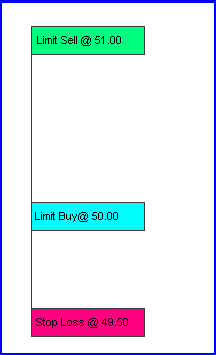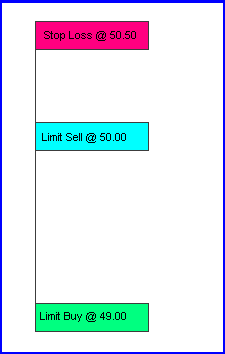
HOT TOPICS LIST
- Strategies
- Stocks
- Buy
- Investing
- Brokers
- Psychology
- Interviews
- Accumulate
- Sell
- Hold
- Spotlight
- Websites
- Candlestick Corner
- Gold & Metals
- Options Trading
LIST OF TOPICS
TRADER'S NOTEBOOK
Bracket Orders
07/28/05 11:20:14 AM PSTby Roberto Chahin
Need a day off? New to the market? Bracket orders can "temp" while you take care of business.
| Have you ever needed to take a day off from trading? We all have, but often don't; we may feel guilty, restrained by work ethics, or anxious that we are behind in our profit goals for the month. But sometimes, you have to take that day off to go to the doctor, or attend your child's school play. And when you need to leave your trading workstation behind, you can still profit by using bracket orders. Bracket orders allow you to set up a few trades during the first hour of trading and walk away to take care of yourself and your family. They are also a good way for novice traders to get their sea legs as they embark on the wild ocean that is daytrading.
DEFINING BRACKET ORDERS
Figure 1: Bullish Bracket Order.
If you decide to short the stock, then the bracket order is started with a sell-limit order, and then bracketed by a stop-loss order above entry price and a profit-taking buy-limit order below the entry. (See Figure 2) This allows you to set up the trade and walk away, since the exit orders have already been sent to your broker.
Figure 2: Bearish Bracket Order.
BUILDING A BRACKET ORDER STRATEGY
Choosing your stocks
Defining the stop loss
Step 1
Let's say for example, we find that XYZ stock has a solid resistance level at 49.50 and we have the opportunity to enter a limit-buy order at 50.00. That means we have a 50 cent difference between probable entry and stop-loss. If we have a $100,000.00 trading account and a 0.5 % limit of that to risk per trade, we can only risk $500.00 on each trade. This limits our position for this trade at 1,000 shares of XYZ.
Defining the profit goal
Step 2 For a bullish position: Going back to our example, we know that our probable entry price at 50.00 and our risk limit per share is 0.50. If our strategy looks for a profit multiple of 2 then we determine that our profit-taking limit order must be placed at 51.00.
Entry and setting the bracket Step 3
If, for some reason, you have to adjust your entry price, you can adjust the other orders accordingly to maintain the same risk limit and profit potential. Make sure that all positions will close at the end of the day if neither the profit-taking limit order nor the stop-loss has been triggered -- you may not want to go into the unpredictable after-hours with an open position. In addition, you may want to check with your broker about order-routing procedures to make sure you can execute this strategy; and make sure that, in case the stop-loss order is triggered, the corresponding profit-taking limit order is cancelled, and vice versa.
NEW TO TRADING? Bracket orders help take the emotion out of the exit, where money is made or lost. The entry opportunity in an intraday trade can be found by many different technical analysis techniques that range from very simple moving averages to customized indicator matrices. Once your chosen technique has given you the go-ahead to enter a trade, your emotions come into play. If fear keeps you from entering, there is no harm done, since your capital is safely in cash form. But if you will yourself to pull the trigger, your money is now in jeopardy. It is now up to your exit to turn a profit or limit your loss. By using a bracket order to close your position, the emotions that may sabotage your trade are taken out of the picture. Since both the stop-loss and the profit-taking limit order takes some of the decision making away from you, the bracket order acts like training wheels until you feel at ease in the market. Once you are ready to move forward, you may stop using the profit-taking limit order and let the profits run. Finally, you could drop the automatic stop-loss, which is, after all, a triggered market order -- and we all know market orders are the unacknowledged fourth member of the Axis of Evil because they are more likely to spawn slippage.
BEYOND THE BRACKET
SUGGESTED READING
Roberto Chahin is a business and personal financial advisor who is now a full-time trader based in Tegucigalpa, Honduras. He may be reached at robertochahin@yahoo.com. Current and past articles from Working Money, The Investors' Magazine, can be found at Working-Money.com.
|
| E-mail address: | robertochahin@yahoo.com |
PRINT THIS ARTICLE

|

Request Information From Our Sponsors
- StockCharts.com, Inc.
- Candle Patterns
- Candlestick Charting Explained
- Intermarket Technical Analysis
- John Murphy on Chart Analysis
- John Murphy's Chart Pattern Recognition
- John Murphy's Market Message
- MurphyExplainsMarketAnalysis-Intermarket Analysis
- MurphyExplainsMarketAnalysis-Visual Analysis
- StockCharts.com
- Technical Analysis of the Financial Markets
- The Visual Investor
- VectorVest, Inc.
- Executive Premier Workshop
- One-Day Options Course
- OptionsPro
- Retirement Income Workshop
- Sure-Fire Trading Systems (VectorVest, Inc.)
- Trading as a Business Workshop
- VectorVest 7 EOD
- VectorVest 7 RealTime/IntraDay
- VectorVest AutoTester
- VectorVest Educational Services
- VectorVest OnLine
- VectorVest Options Analyzer
- VectorVest ProGraphics v6.0
- VectorVest ProTrader 7
- VectorVest RealTime Derby Tool
- VectorVest Simulator
- VectorVest Variator
- VectorVest Watchdog


